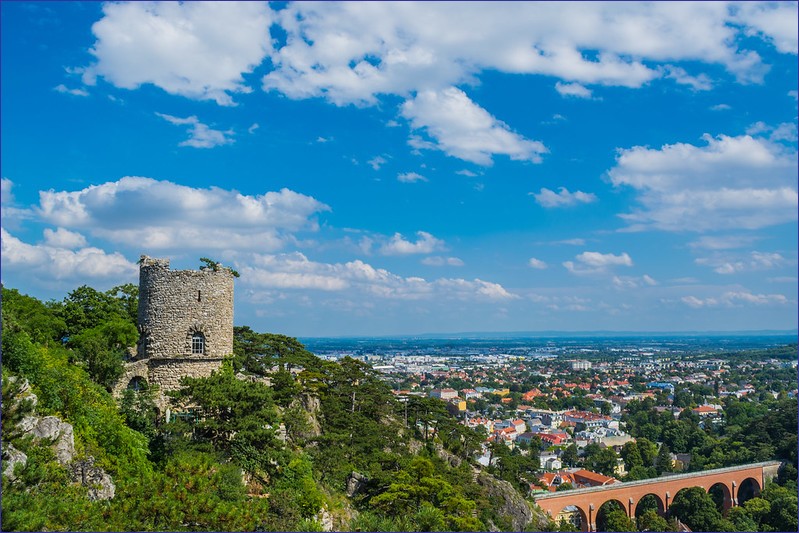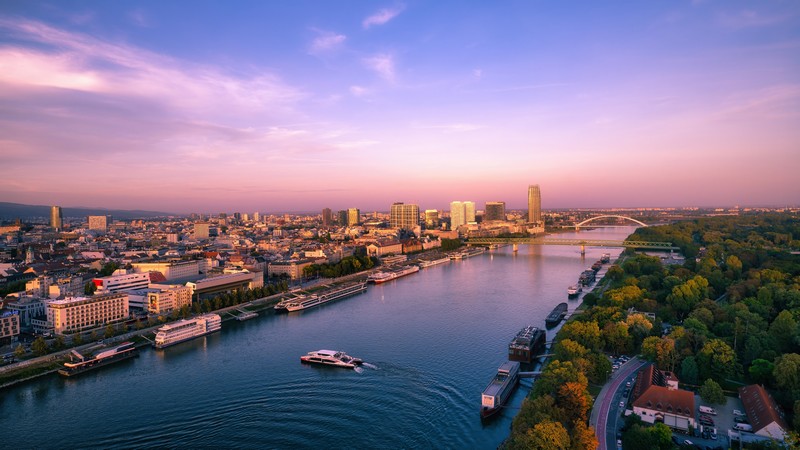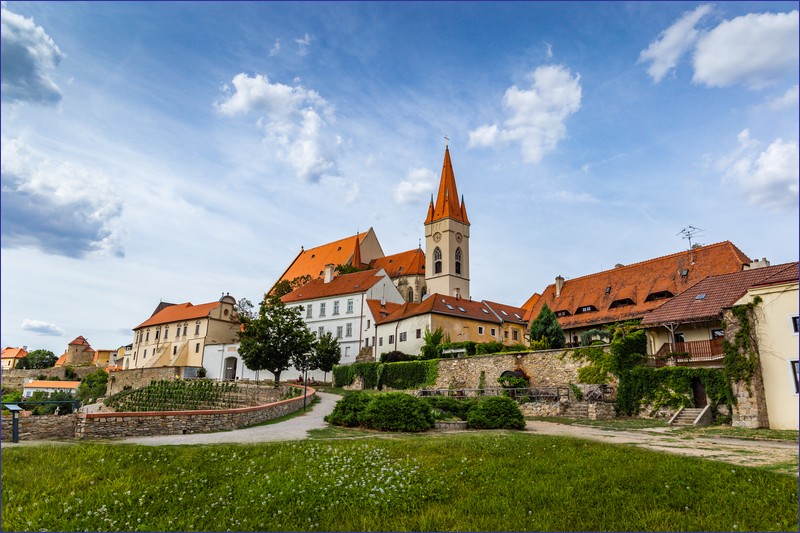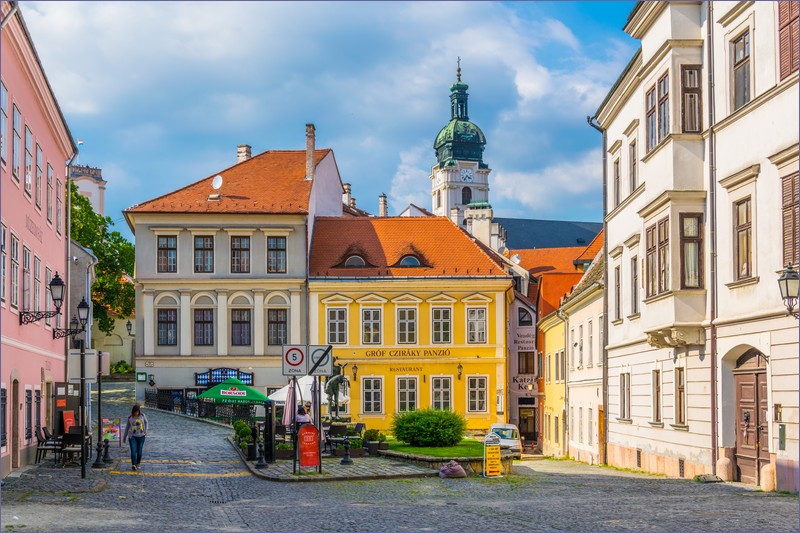Vienna is a beautiful city and the capital of Austria. The city boasts a wealth of world-class historical landmarks, a well-maintained city center, and numerous museums worth visiting. Vienna is also an excellent base for planning railway day trips. In this article, I briefly present suggestions for day trips from Vienna by train, most commonly using regional trains. Thanks to excellent rail connections and travel deals that make journeys affordable, it’s easy to reach towns near the capital or interesting destinations in neighboring countries by train.
The article includes places that can be reached from Vienna within two hours by regional train, with exceptions for Győr and Brno.
Mödling
Located 15 kilometers south of Vienna, the towns of Mödling and Hinterbrühl lie close to one another.
Mödling is a charming town with around 20,000 residents, known for its attractive old town and historic landmarks. The main attractions include Liechtenstein Castle and the ruins of an ancient fortress overlooking the town. These 11th-century ruins are the oldest in the area. Another notable site is the Black Tower, a remnant of a different castle, offering a panoramic view of the town and surrounding area, including the aqueduct that supplies water to Vienna.
The town features beautifully decorated townhouses, and right next to the train station is the Municipal Transport Museum, home to a collection of vintage trams.
Numerous forest hiking trails have been marked in the surrounding area.
Train access: Mödling is served by S-Bahn line S2 from Vienna, and regional trains also stop there.

Hinterbrühl
Hinterbrühl is a small town located a few kilometers west of Mödling. It is famous for Europe’s largest underground lake, found in the Seegrotte cave. The lake was formed after an explosion in a local gypsum mine in the early 20th century. During World War II, the Nazis used the cave to assemble fighter planes. After the war, the cave was flooded again and has since become one of the region’s most popular tourist attractions.
Train access: The town is located 3.5 kilometers west of the Mödling train station mentioned above.
Laxenburg
Laxenburg is a small town (with fewer than 3,000 inhabitants) located just a few kilometers south of Vienna. The town features a charming main square and a large park with Franzensburg Castle, built on a small island between 1801 and 1836. Also located here is the Old Castle (palace), which is open for guided tours during the tourist season.
Train access: The town has a train station called Laxenburg-Biedermannsdorf, served by trains on the Vienna – Traiskirchen Aspangbahn line.
Melk Abbey
The Benedictine Abbey in Melk was founded in the early Middle Ages on the site of a former fortress. The Benedictines have inhabited the complex since 1089. The abbey gained its current appearance after being rebuilt in Baroque style in the 18th century, making it one of the largest Baroque religious monuments in Europe. It is also known for its monastic reform in the 15th century, when the monks returned to a life of virtue and asceticism; the Melk reform later inspired other Benedictine monasteries.
Visitors are especially impressed by the interior of the Church of Saints Peter and Paul, the monastic library, and the state room. Tours are conducted with a guide, and photography is prohibited in most areas.
The town of Melk itself is also worth visiting, with a small, charming historic center.
Train access: Melk station is served by ÖBB trains from Vienna Westbahnhof to Amstetten. It can also be reached by changing trains in St. Pölten, or via the Wachau Valley Railway.
Sopron (Hungary)
If you decide to visit Forchtenstein Castle, it’s also worth taking a trip to Sopron, a town just across the Austrian-Hungarian border. It is considered one of the most beautiful cities in Hungary. The city center was not damaged during the wars. Notable landmarks and attractions include the Firewatch Tower (about 60 meters high, dating back to the 12th century), the Town Hall, several churches, remnants of medieval city walls, the Esterházy Palace, and a synagogue. It’s definitely a city worth visiting.
Train access: There are direct trains from Vienna to Sopron as well as from Wiener Neustadt to Sopron. Sopron’s railway station is located in the city center, close to the main landmarks and attractions.
Klosterneuburg
Klosterneuburg is a town located just north of Vienna, right beyond the city limits. The symbol of the town is the Abbey of the Augustinian Canons, situated on a hill overlooking the Danube River. In 1114, Margrave Leopold III of Babenberg ordered a church to be built at this site, which in 1133 was handed over to the monks.
At the abbey, visitors can see the chapel from 1318 with Leopold III’s tomb, a 12th-century altarpiece, a library with 30,000 volumes, a painting gallery, and a coin collection. Most areas are visited as part of guided group tours.
Train access: There are two train stops in Klosterneuburg served by regional trains running from Wien Franz-Josefs-Bahnhof to Tulln. The abbey is visible from the train windows.
Kreuzenstein Castle
Just a few kilometers north of Vienna, in the small town of Leobendorf, lies one of Austria’s most fascinating castles – Kreuzenstein Castle.
The first fortress at this site was built in the early 12th century. In 1278, the castle came under Habsburg control. It was reconstructed between 1874 and 1906. The castle was badly damaged and looted during military operations in 1945.
From the outside, the castle looks like something out of a fairytale. Visits are only possible with a guide from April to October; photography inside the castle is not allowed.
Train access: The Leobendorf-Burg Kreuzenstein railway station is located 3 km from the castle and is served by suburban lines S3 and S4.
Krems an der Donau
A very charming town with a rich history, Krems an der Donau was formed from the merger of two towns – Krems and Stein. With around 24,000 inhabitants, Krems has two old towns and is the most important city in the Wachau Valley.
Historical landmarks and attractions include remnants of old city fortifications with city gates (the most notable being Steiner Tor), sacred buildings such as the Church of St. Vitus (from the mid-12th century), well-preserved bourgeois townhouses, and several museums.
It’s a cozy town with narrow, and in some places steep streets, charming alleys, and a pleasant atmosphere. In summer and on weekends, it can get quite crowded.
Train access: Trains from Wien Franz-Josefs-Bahnhof travel to Krems an der Donau. The train journey from Vienna to Krems takes about one hour, with scenic views along the way. From St. Pölten, it takes just 30 minutes.
Dürnstein
Dürnstein is a historic town located just a few kilometers west of the previously mentioned Krems an der Donau. It was built near a medieval fortress that towers over the Danube Gorge. Dürnstein is known in history as the place where King Richard I the Lionheart of England was once held captive in the local castle.
In Dürnstein, it’s worth seeing the castle ruins above the town, remnants of the defensive walls, and the abbey (much smaller than the one in Melk). The experience is completed by narrow streets lined with well-kept townhouses. It’s definitely a place worth visiting.
Train access: The nearest station with year-round scheduled Austrian Railways service is Krems an der Donau (about 8 km away). Dürnstein does have its own train station, but it is only served by Wachaubahn trains, which run from March through October – more information can be found online.
Bratislava (Slovakia)
It might seem odd to include Bratislava when discussing day trips from Vienna, but it’s not surprising at all—the two cities are very close, and Bratislava lies right at the Slovak-Austrian border. The cities are well connected by rail, and affordable train tickets are available. The Slovak capital is an excellent option for a day trip from Vienna.
Bratislava is located at the tripoint of Slovakia, Austria, and Hungary. Some travelers consider the city dull and uninteresting, but I found the compact historic center quite appealing. The main highlights of a typical walk through Bratislava include the Michael’s Gate, the Main Square, the National Theatre, Bratislava Castle, and a stroll along the Danube. You can also take local buses to visit Devin Castle.
Train access: There are many train between Vienna and Bratislava.

Day Trip to the Czech Republic
From Vienna, it’s very easy to reach the Czech Republic by train (though not always cheap). EC and IC trains take less than an hour to reach Břeclav, and around 90 minutes to Brno, the second-largest city in the Czech Republic. If you’re planning this kind of trip, it’s worth spending a full day exploring South Moravia, or even a weekend if you want to include Brno in your itinerary.
Listing all the attractions of the Austrian-Czech border region would go beyond the scope of this guide, but it’s worth mentioning Brno, Mikulov, Znojmo, Lednice, Valtice, and Vranov nad Dyjí. These are just a few of the highlights. From Znojmo, you can catch a train to the Austrian town of Retz, and from there head back to Vienna. There are many options to choose from.

Győr (Hungary)
A mid-sized city with over 130,000 residents, Győr is an important industrial, administrative, and cultural center. Its history dates back to the 5th century BC, when the Celtic settlement of Arrabona was located here.
Győr is considered one of Hungary’s most beautiful cities, at least in terms of its historic center, though the city also has many apartment blocks, and the train and bus stations are not exactly charming.
The city center is rich in secular and religious monuments. Noteworthy buildings include the 1900 City Hall, the 18th-century Old City Hall, and the Esterházy Palace. Important religious landmarks include the Cathedral of the Assumption of the Virgin Mary, the 18th-century Carmelite Monastery, the Carmelite Church, and the synagogue.
Historically, the town center was located on Káptalan Hill, at the confluence of the Danube and Rába Rivers.
There’s also a small zoo worth visiting in the city.
Personally, I recommend Győr. The center is neither too big nor too small, making it enjoyable to explore—with compact buildings, picturesque corners and streets, though accommodation prices can be high.
Train access: Railjet trains from Vienna to Budapest and Regiojet trains from Prague to Budapest (via Vienna) stop in Győr. The train station is very close to the city’s main attractions. The train ride from Budapest to Győr takes about 80 minutes.
Related articles:
Train travel in Austria – a comprehensive guide
